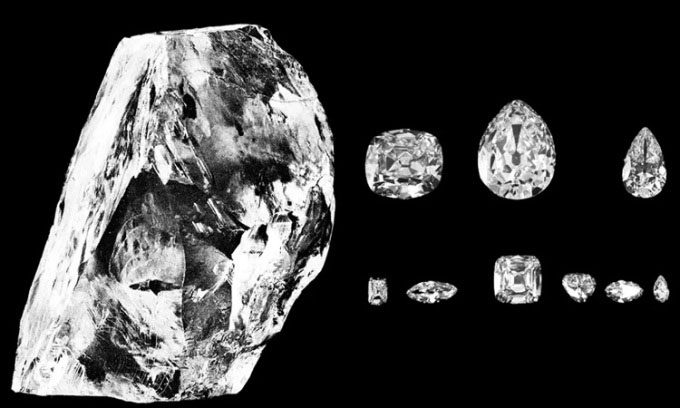The largest rough diamond ever discovered is known as the Cullinan, found in South Africa in 1905.

The Cullinan rough diamond and 9 gemstones derived from it. (Photo: Wikipedia).
The Cullinan is a colossal diamond weighing 3,106 carats with dimensions of 10.1 x 6.35 x 5.9 cm. This weight is equivalent to 621 grams, about the same as a basketball or 7,692 bees, according to IFL Science.
On January 25, 1905, Frederick Wells, the manager of the Premier mine in Pretoria, South Africa, noticed a flash of light from something in the wall above while he was 5.5 meters underground. Wells retrieved the diamond and presented it to Sir Thomas Cullinan, the mine’s owner, later that day. However, no one was willing to purchase the diamond named after Cullinan until 1907. Eventually, the Transvaal provincial government acquired the gemstone as a birthday gift for King Edward VII of the United Kingdom. Fearing it might be stolen during transport from Africa to London, King Edward arranged for a replica diamond to be placed on the steamship surrounded by detectives as a decoy, while the Cullinan was sent to England in a simple box.
Because the Cullinan was too large to be kept in its original form, King Edward entrusted the cutting of the diamond to Joseph Asscher, head of the Asscher Diamond Company in Amsterdam. Asscher, who had previously cut the Excelsior diamond, which weighed 971 carats and was the record holder at the time, studied the gemstone for six months before attempting to cut it. In the first attempt, the steel blade broke while the diamond remained intact. In the second attempt, the experts took four days to create a 1.3 cm deep cleft, allowing them to split the gemstone into two halves with a single strike. Asscher then fainted from exhaustion and extreme anxiety. For the next eight months, three workers toiled for 14 hours a day to complete the cutting of the diamond. Ultimately, the Cullinan was cut into 9 large diamonds, numbered I-IX, along with nearly 100 smaller stones, valued at millions of USD.
The largest of these is known as Cullinan I, also called the Star of Africa, weighing 530.2 carats (106 g), equivalent to 32 tea bags. All nine large stones belong to the British royal family, primarily used to adorn crowns and various other jewelry, such as necklaces.
The second-largest diamond after the Cullinan is the Excelsior, discovered by miners at the Jagersfontein mine in South Africa in 1893. The Jagersfontein mine is where two of the ten largest diamonds in the world were discovered. The other diamond is named Jubilee, weighing 245.35 carats.





















































